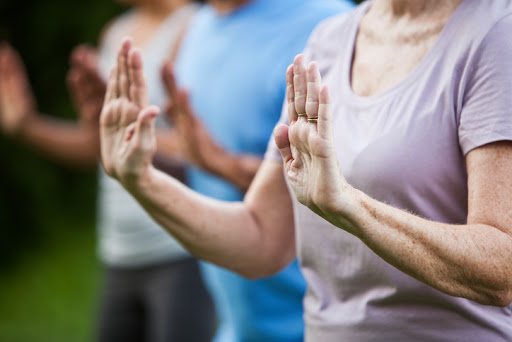Table of Contents
Introduction: A Holistic Approach to Wellness
In today’s world of fast-paced routines and chronic stress, many individuals are turning toward ancient wellness practices to regain balance and vitality. Among the most effective and time-tested of these are tai chi and qigong. These gentle yet powerful Chinese disciplines offer a natural and sustainable way to improve mental clarity, physical health, and emotional stability without harsh impacts on the body.
What Are Tai Chi and Qigong?
Though often grouped together, tai chi and qigong are distinct yet complementary practices rooted in Traditional Chinese Medicine (TCM).
- Tai Chi (Taijiquan): A form of internal martial arts characterized by slow, flowing movements and postures performed in a meditative manner. Originally developed for self-defense, it is now widely practiced for its health benefits and stress relief.
- Qigong (pronounced “chee-gong”): A broader practice that integrates breathing techniques, focused intention, gentle movements, and meditation to cultivate and balance “Qi” or life energy in the body.
Together, they provide a comprehensive path to physical, mental, and spiritual well-being.
Health Benefits of Tai Chi and Qigong
1. Enhancing Balance and Flexibility
The slow, deliberate motions of tai chi and qigong help improve joint mobility and muscle control, making them ideal for seniors or those recovering from injuries. Practicing these movements regularly improves balance, posture, and range of motion.
Long-tail keyword in use:
- balance exercises for older adults
- gentle movement therapy for joint pain
2. Reducing Stress and Anxiety Naturally
Both practices involve deep breathing and meditative focus, which helps reduce cortisol levels and calm the nervous system. Unlike high-intensity workouts, they soothe the body and mind simultaneously.
Long-tail keyword in use:
- natural stress reduction techniques
- mindful breathing exercises for anxiety
3. Improving Cardiovascular Health
Studies have shown that regular practice of tai chi and qigong can help regulate blood pressure, improve circulation, and enhance heart health—especially in individuals who cannot engage in strenuous exercise.
4. Boosting Immunity and Energy Flow
Qigong, in particular, emphasizes the cultivation and circulation of energy (Qi) throughout the body. It is believed that consistent practice strengthens the immune system and increases vitality over time.
Long-tail keyword in use:
- energy healing exercises for immunity
- qigong routines for fatigue relief
5. Enhancing Mental Clarity and Focus
Meditative movement enhances cognitive performance by training the mind to remain present and focused. This helps reduce mental clutter and promotes emotional balance.
Key Differences Between Tai Chi and Qigong
| Feature | Tai Chi | Qigong |
|---|---|---|
| Primary Focus | Martial arts and meditation | Energy cultivation and healing |
| Movement Style | Complex, choreographed forms | Repetitive, simple movements |
| Learning Curve | Requires time and guidance | Easier to learn for beginners |
| Applications | Self-defense, health, meditation | Therapeutic, spiritual, and wellness |
Though different in execution, the two practices often complement each other, and many practitioners integrate both into their daily routines for holistic benefits.
How to Begin Practicing Tai Chi and Qigong
1. Start with Breathing Awareness
Before diving into full movements, begin with deep abdominal breathing exercises. This lays the foundation for both tai chi and qigong practices.
2. Learn Foundational Poses
Common qigong poses like “Holding the Ball” or “Standing Like a Tree” are excellent for beginners. For tai chi, the “Yang-style 24 Form” is a popular starting point.
3. Practice Consistency Over Perfection
Rather than striving for perfect form, focus on consistency and mindfulness. Even 10–15 minutes a day of slow, intentional movement can yield noticeable improvements.
4. Join Local Classes or Follow Guided Videos
While live instruction is beneficial for alignment and feedback, many online resources can guide you step-by-step in your journey.
Tai Chi and Qigong for Specific Populations
Seniors and Aging Adults
These practices help prevent falls, enhance mobility, and alleviate age-related ailments like arthritis and osteoporosis.
Office Workers and Busy Professionals
Even short sessions during breaks can reduce screen fatigue, relieve back pain, and enhance focus at work.
People Recovering from Illness
Tai chi and qigong provide gentle rehabilitation for individuals recovering from surgeries or managing chronic conditions like fibromyalgia, hypertension, and depression.
Common Misconceptions About Tai Chi and Qigong
Myth: They are too slow to be effective.
Fact: Their slow pace is intentional—it engages deep muscles, focuses the mind, and supports long-term wellness.
Myth: They are only for the elderly.
Fact: People of all ages and fitness levels can benefit, including athletes, teenagers, and those with disabilities.
Myth: You need prior experience in martial arts.
Fact: No previous experience is needed; both practices are beginner-friendly and adaptable.
FAQs: Tai Chi and Qigong
Q1: Can I practice tai chi and qigong together?
A: Yes, many practitioners integrate both to balance physical movement with energy healing techniques.
Q2: Do I need special equipment or clothing?
A: No. Loose, comfortable clothing and a quiet space are all you need.
Q3: How long before I notice benefits?
A: Some benefits, like reduced stress, can be felt immediately, while others (like improved flexibility or balance) may take a few weeks of regular practice.
Q4: Is it safe for people with health conditions?
A: Generally, yes. However, it’s always best to consult your healthcare provider before beginning any new exercise program, especially if you have specific medical concerns.
Q5: Can children practice tai chi and qigong?
A: Absolutely. These practices can improve focus, coordination, and emotional regulation in children as well.
Conclusion: Embrace Inner Harmony and Vitality
As the world becomes more technologically complex, the need for simplicity, mindfulness, and inner balance grows stronger. Tai chi and qigong offer timeless tools for cultivating wellness through gentle movement, mindful breathing, and energy awareness. Whether you’re seeking physical vitality, emotional peace, or spiritual connection, these ancient arts provide a meaningful path toward holistic well-being.
By incorporating even a few minutes of daily practice into your routine, you begin a journey that nurtures both the body and the soul.

